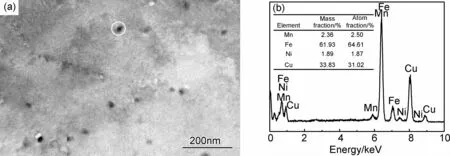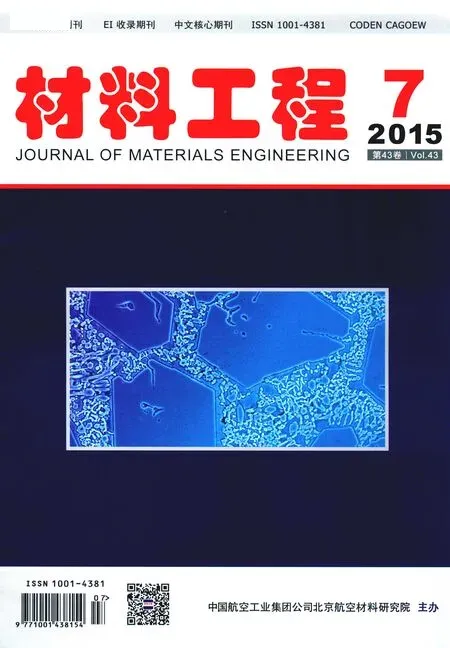RPV模拟钢中纳米富Cu析出相的复杂晶体结构表征
冯 柳,周邦新,彭剑超,王均安
(1 上海大学 材料研究所,上海 200072;2 山东理工大学 分析测试中心,山东 淄博 255049;3上海大学 微结构重点实验室, 上海 200444)
RPV模拟钢中纳米富Cu析出相的复杂晶体结构表征
冯 柳1,2,周邦新1,3,彭剑超1,3,王均安1,3
(1 上海大学 材料研究所,上海 200072;2 山东理工大学 分析测试中心,山东 淄博 255049;3上海大学 微结构重点实验室, 上海 200444)
RPV模拟钢样品经过890℃水淬,660℃调质处理,然后在400℃时效13000h后,用高分辨透射电镜和能谱仪相结合的方法研究了RPV模拟钢中纳米富Cu析出相中的复杂晶体结构。纳米富Cu析出相的平均尺寸约为20nm,除了观察到常见的亚稳态9R结构、3R结构和稳态fcc结构外,还观察到同一富Cu析出相由3种不同的晶体结构组成,并分别分布在5个不同的区域中,包括1处9R、2处fcc 和2处3R 结构。9R结构与相邻的2个fcc结构形成的界面都具有特定的晶体取向,呈半共格关系,是由非孪晶9R结构演化而来。2处3R结构互为孪晶关系,是由孪晶9R结构演化而来。这种状态反映了纳米富Cu析出相从亚稳态演化到稳态结构的复杂过程。
RPV模拟钢;热时效;纳米富Cu析出相;9R晶体结构

本工作采用HRTEM和能谱仪(EDS)相结合的方法,研究了660℃调质处理后的RPV模拟钢在400℃时效13000h后析出富Cu相中的某些复杂晶体结构特征,为认识RPV钢中纳米富Cu相的晶体结构演变及辐照脆化机理提供了实验依据。
1 实验材料与方法
目前,大多数压水堆核电站的RPV均采用Mn-Ni-Mo低合金铁素体钢(A508-Ⅲ),其中的Cu为炼钢原料中引入的杂质元素,标准中规定其含量应低于0.08%(质量分数,下同),Ni含量在0.4%~1.0 %之间。本实验所用材料是在A508-Ⅲ钢成分基础上提高了Cu和Ni的含量,这种改变了成分的钢称为RPV模拟钢,化学成分如表1所示。
钢锭质量约40kg,由真空感应炉冶炼,将钢锭经热锻和热轧制成6mm厚的钢板,然后再切成35mm×40mm的小样品。随后在890℃加热0.5h后水淬,在660℃加热10h进行调质处理,最后在400℃进行了长达13000h的时效处理。本实验提高了RPV钢中Cu和Ni的含量,并选用了高于RPV运行温度(290℃)的400℃时效,这主要是为了能够方便地观察到热时效过程中富Cu相的析出以及长大过程中晶体结构的转变。
采用电火花线切割方法将时效处理后的样品沿截面切下厚度约0.5mm的薄片,然后用砂纸将其磨薄至0.1mm,用冲片机冲出直径为3mm的圆片,再用细砂纸将其磨至约50μm,最后用10%HClO4+90%C2H5OH溶液在-40℃ 进行双喷电解抛光。采用JEM-2010F HRTEM观察富Cu相的微观结构,并用INCA-OXFORD能谱仪对析出相进行成分分析。HRTEM图像用Digital Micrograph软件进行辅助分析,研究析出相的晶体结构。

表1 RPV模拟钢的化学成分(质量分数/%)
2 结果与分析
2.1 富Cu析出相的HRTEM观察
图1为纳米富Cu析出相的分布状态及元素分析结果,图1(a)中可以看出,富Cu相的平均尺寸约为20 nm,形貌主要以椭球形为主。与时效1000h的RPV模拟钢中析出的纳米富Cu析出相相比[20],数量密度较低。图1(b)为(a)图圆圈内一个析出相的EDS分析结果,析出相中除含有34%的Cu外,还有大量的Fe及少量的Mn和Ni。因为富Cu相尺寸较小,能谱分析结果中有部分Fe的含量可能源自基体,所以Fe比实际析出相中的含量偏高,导致Cu含量偏低。

图1 RPV模拟钢样品调质处理后在400℃时效13000h得到富Cu析出相的分布状态和富Cu相的元素分析(a)TEM图像;(b)图(a)中白色圆圈内富Cu析出相的EDS分析结果Fig.1 Distribution and element analysis of Cu-rich precipitates in RPV model steel after aging at 400℃ for 13000h (a)TEM micrograph;(b)EDS analysis of a Cu-rich precipitate marked with a white circle in fig.(a)
为了研究富Cu相的晶体结构,需要拍摄HRTEM图像进行分析。在拍摄HRTEM图像时,将电子束入射方向调整至与α-Fe基体的〈111〉方向平行。所观察到的富Cu相中除常见的亚稳态3R结构、9R结构和稳态fcc结构外,还观察到同一个富Cu相中具有多种晶体结构的复杂现象。图2为典型的具有复杂晶体结构的富Cu析出相,此富Cu相的大小约27 nm,可以看出该富Cu相的图片中具有不同方向的莫尔条纹,由于该富Cu相嵌入的基体是一个单晶体,同一个富Cu相中存在不同方向的莫尔条纹,只可能是该富Cu相中存在不同的晶体结构或者是不同的晶体取向。按照莫尔条纹的走向将其分为5个区域,以便详细地分析其晶体结构和晶体取向的差别,如图2(a)中白线所标示。图2(b)为富Cu相的能谱分析结果,Cu含量约为60%,仍含有35%左右的Fe和少量的Ni和Mn。


图2 一个富Cu相的微观形貌图及该富Cu相的元素分析 (a)HRTEM图;(b)EDS分析结果Fig.2 Micrograph and element analysis of Cu-rich precipitate (a)HRTEM micrograph;(b)EDS analysis of Cu-rich precipitate

图3 富Cu相区域1~3之间的FFT和IFFT图 (a)区域“1”的FFT图;(b)区域“1”的IFFT图;(c)区域“2”的FFT图;(d)区域“1”和区域“2”界面附近IFFT图;(e)区域“3”的FFT图;(f)区域“1”和区域“3”界面附近的IFFT图Fig.3 FFT and IFFT patterns of the Cu-rich precipitate from region 1 to 3 (a)FFT pattern of region “1”; (b)IFFT pattern of region “1”;(c)FFT pattern of region “2”;(d)IFFT pattern near the interface of region “1” and “2”;(e)FFT pattern of region “3”;(f)IFFT pattern near the interface of region “1” and “3”


图4 富Cu相区域4,5的FFT和IFF图 (a)区域“4”的FFT图;(b)区域“5”的FFT图;(c)区域“4”的IFFT图;(d)区域“5”的IFFT图;(e)区域“3”和区域“4”界面附近的IFFT图;(f)区域“4”和区域“5”界面附近的IFFT图Fig.4 FFT and IFFT patterns of the Cu-rich precipitate between region 4 and 5 (a)FFT pattern of region “4”; (b)FFT pattern of region “5”;(c)IFFT pattern of region “4”;(d)IFFT pattern of region “5”;(e)IFFT pattern near the interface between region “3” and region “4”;(f)IFFT pattern near the interface between region “4” and region “5”
上述对图2(a)的一系列分析表明,此富Cu相中包括了9R,3R 和fcc等3种不同的晶体结构,分别分布在5个不同的区域中。在“1”,“2”,“3”区域中,9R与其相邻两侧的fcc结构组成的界面呈半共格关系。Heo等[25]报道了非孪晶9R结构可以直接转变为fcc结构,而不需要优先转变为3R结构。9R到fcc结构演变的过渡结构是由9R及其两侧的fcc结构组成。本工作观察到富Cu相中的 “1”,“2”,“3” 区域与此现象类似,可以认为是9R结构向孪晶fcc结构演化的过渡阶段。区域“4”和“5”都为3R结构,且互为孪晶关系,根据目前的研究结果[26],9R孪晶结构会继续演变为更稳定的3R结构,可以认为此结构是由9R孪晶结构经过切变后形成。
2.2 讨论
RPV模拟钢中提高了Cu的含量,同时Ni,Mn元素也会促进富Cu相的析出[27,28],形核时间较短,所以试样在400℃时效时间13000h后,富Cu相应处于长大或粗化阶段,这时富Cu相尺寸不断增大,数量密度减小,相间距也变大[29]。富Cu相长大的过程中,其晶体结构会发生一系列复杂的变化。图2(a)中所示的富Cu相,为亚稳态的9R结构继续向更稳定的晶体结构演化时的过渡状态,区域“1”,“2”,“3”和区域“4”,“5”的演变机理都是通过不全位错沿9R结构的(001)9R基面进行a/3 [100]9R大小的切变[25,30],但切变方向不同。



图5 非孪晶9R向fcc/9R/fcc结构演化的简化示意图及富Cu相与之相对应的原子排列(a)简化示意图;(b)区域“1”,“2”与(a)相对应的原子排列Fig.5 The schematic diagram showing the transformation of non-twin 9R to fcc/9R/fcc crystal structure (a)the schematic diagram;(b)the corresponding atoms arrangement in region “1” and “2” of the Cu-rich precipitate

图6 孪晶9R向孪晶3R结构演化的简化示意图及富Cu相与之相对应的原子排列(a)简化示意图;(b)区域“4”,“5”与(a)相对应的原子排列Fig.6 The schematic diagram showing the transformation of twin 9R to twin 3R crystal structure (a) the schematic diagram;(b)the corresponding atoms arrangement in region “4”, “5” of the Cu-rich precipitate
图5和图6说明了非孪晶9R结构、孪晶9R结构的演化机理相似,但切变方向和切变原子面明显不同,所得晶体结构也会完全不同。9R结构、3R结构、fcc结构的晶格常数都不同,所以原子切变后晶格会发生一定程度的畸变,但会通过方向相反的a/3 [100]9R大小的切变两两抵消。需要说明的是,在图5,6中为了说明不同结构间每层原子的对应关系,将两对应c轴长度设置为相等。由于此富Cu相由3种不同的晶体结构组成并分布在5个不同的区域中,所以可推断此富Cu相最终可能会形成稳态的fcc多孪晶结构,但包括两种不同的演化序列:非孪晶9R结构直接转变为fcc结构;9R孪晶结构优先转变为3R孪晶结构再转变为fcc孪晶结构。
3 结论
(1)纳米富Cu析出相的平均尺寸约为20nm,除了观察到常见的亚稳态9R结构、3R结构和稳态fcc结构外,还观察到同一富Cu相由3种不同的晶体结构组成,并分别分布在5个不同的区域中,包括1处9R、2处fcc 和2处3R 结构。
(2)9R结构与相邻的2个fcc结构形成的界面都具有特定的晶体取向,呈半共格关系,是由非孪晶9R结构演化而来。2处3R结构互为孪晶关系,是由孪晶9R结构演化而来。这种状态反映了纳米富Cu析出相从亚稳态演化到稳态结构的复杂过程。
[1] ZHANG Z W, LIU C T, WANG X L, et al. Effects of proton irradiation on nanocluster precipitation in ferritic steel containing fcc alloying additions[J]. Acta Mater, 2012, 60(6-7):3034-3046.
[2] STYMAN P, HYDE J, WILFORD K, et al. Precipitation in long term thermally aged high copper, high nickel model RPV steel welds[J]. Prog Nucl Energ, 2012, 57(5):86-92.
[3] LAMBRECHT M, MESLIN E, MALERBA L, et al. On the correlation between irradiation-induced microstructural features and the hardening of reactor pressure vessel steels[J]. J Nucl Mater, 2010, 406(1):84-89.
[4] FUJII K, NAKATA H, FUKUYA K, et al. Hardening and microstructural evolution in A533B steels under neutron irradiation and a direct comparison with electron irradiation[J].J Nucl Mater, 2010, 400(1):46-55.
[5] RADIGUET B, PAREIGE P, BARBY A. Irradiation induced clustering in low copper or copper free ferritic model alloys[J]. Nucl Instrum and Methods Phys Res B, 2009, 267:1496-1499.
[6] 吕铮. 核反应堆压力容器的辐照脆化与延寿评估[J].金属学报,2011,47(7):777-783.
LU Z. Radiation-induced embrittlement and life evaluation of reactor pressure vessels[J]. Acta Metall Sin, 2011, 47(7): 777-783.
[7] NIFFENEGGER M, LEBER H. Monitoring the embrittlement of reactor pressure vessel steels by using the Seebeck coefficient[J]. J Nucl Mater, 2009,389(1): 62-67.
[8] BERGNER F, LAMBRECHT M, ULBRICHT A, et al. Comparative small-angle neutron scattering study of neutron-irradiated Fe, Fe-based alloys and a pressure vessel steel[J]. J Nucl Mater, 2010, 399(2-3):129-136.
[9] TIMOFEEV B. Assessment of the first generation RPV state after designed lifetime[J]. Int J of Pres Ves Pip, 2004, 81:703-712.
[10] LEE K, KIMB M, LEEB B, et al. Analysis of the master curve approach on the fracture toughness properties of SA508 Gr.4N Ni-Mo-Cr low alloy steels for reactor pressure vessels[J]. Mater Sci Eng A, 2010, 527: 3329-3334.
[11] CAMMELLI S, DEGUELDRE C, CERVELLINO A, et al. Cluster formation, evolution and size distribution in Fe-Cu alloy:Analysis by XAFS XRD and TEM[J]. Nucl Instrum and Methods Phys Res B, 2010, 268:632-637.
[12] SCHOBER M, EIDENBERGER E, STARON P, et al. Critical consideration of precipitate analysis of Fe-1at% Cu using atom probe and small-angle neutron scattering[J]. Microsc Microanal, 2011, 17(1):26-33.
[13] KAMADA Y, TAKAHASHI S, KIKUCHI H, et al. Effect of pre-deformation on the precipitation process and magnetic properties of Fe-Cu model alloys[J]. J Mater Sci, 2009, 44: 949-953.
[14] KOLLI R, SEIDMAN D. The temporal evolution of the decomposition of a concentrated multicomponent Fe-Cu-based steel[J]. Acta Mater, 2008, 56: 2073-2088.
[15] 张植权, 周邦新, 蔡琳玲, 等. 利用APT研究RPV模拟钢中相界面原子偏聚特征[J]. 材料工程, 2014, (9): 89-93.
ZHANG Zhi-quan, ZHOU Bang-xin, CAI Lin-ling, et al. Characterization of atom segregation at phase interfaces in RPV model steel by APT[J]. Journal of Materials Engineering , 2014, (9): 89-93.
[16] HABIBI H. Atomic structure of the Cu precipitates in two stages hardening in maraging steel[J]. Mater Lett, 2005, 59: 1824-1827.
[17] LEE T, KIM Z Y, KIM S. Crystallographic model for bcc-to-9R martensitic transformation of Cu precipitates in ferritic steel[J]. Philos Mag A, 2007, 87(2):209-224.
[18] HABIBI-BAJURIANI H, JENKINS M. High-resolution electron microscopy analysis of the structure of copper precipitates in a martensitic stainless steel of type PH 15-5[J]. Philos Mag Lett, 1996, 73(4): 155-162.
[19] BLACKSTOCK J, ACKLA G. Phase transitions of copper precipitates in Fe-Cu alloys[J]. Philos Mag A, 2001, 81:2127-2148.
[20] 蔡琳玲,徐刚,冯柳,等. 核反应堆压力容器模拟钢中纳米富Cu相的变形特征[J].上海大学学报:自然科学版,2012, 18(3):311-316.
CAI L L, XU G, FENG L, et al. Deformation characterization of nano-scale Cu precipitates in RPV model steel[J]. J Shanghai Univ:Nat Sci, 2012, 18(3): 311-316.
[21] OTHEN P, JENKINS M, SMITH G, et al. Transmission electron microscope investigations of the structure of copper precipitates in thermally aged Fe-Cu and Fe-Cu-Ni[J]. Philos Mag Lett, 1991, 64: 383-391.
[22] DUPARC H, DOOLE R, JENKINS M, et al. A high-resolution electron microscopy study of copper precipitation in Fe-1.5 wt% Cu under electron irradiation[J]. Philos Mag Lett, 1995, 71:325-333.
[23] MOZEN R, JENKINS M, SUTTON A. The bcc-to-9R martensitic transformation of Cu precipitates and the relaxation process of elastic strains in an Fe-Cu alloy[J]. Philos Mag A, 2000, 80(3): 711-723.
[24] 徐刚,楚大峰,蔡琳玲,等. RPV模拟钢中纳米富Cu相的析出和结构演化研究[J]. 金属学报,2011,47(7): 905-911.
XU G, CHU D F, CAI L L, et al. Investigation on the precipitation and structure evolution of Cu-rich nanophase in RPV model steel[J]. Acta Metall Sin, 2011,47(7): 905-911.
[25] HEO Y, KIM B Y, KIM J, et al. Phase transformation of Cu precipitates from bcc to fcc in Fe-3Si-2Cu alloy[J]. Acta Mater, 2013,61: 519-528.
[26] OTHEN P,JENKINS M, SMITH G. High resolution electron microscopy studies of the structure of Cu-precipitates in α-Fe[J]. Philos Mag A, 1994, 70:1-24.
[27] FUJII K, OHKUBO T, FUKUY K. Effects of solute elements on irradiation hardening and microstructural evolution in low alloy steels[J]. J Nucl Mater, 2011, 417: 949-952.
[28] MILLER M, WIRTH B, ODETTE G. Precipitation in neutron-irradiated Fe/Cu and Fe/Cu/Mn model alloys: a comparison of APT and SANS data[J]. Mater Sci Eng A, 2003, 353:133-139.
[29] 安治国,任慧平,刘宗昌,等. 1.18Cu高纯钢等温时效时富铜相的析出行为[J]. 特殊钢,2006, 27(2): 20-22.
AN Z G, REN H P, LIU Z C, et al. Precipitation behavior of rich copper phase in 1.18Cu high purity steel during isothermal aging[J]. Special Steel, 2006, 27(2): 20-22.
[30] 王伟. 反应堆压力容器模拟钢中富Cu相的析出及晶体结构演化研究[D].上海:上海大学,2011.
WANG W. Precipitation and structural evolution of copper-rich nano phases in reactor pressure vessel model steels [D]. Shanghai: Shanghai University, 2011.
Characterization of a Complex Crystal Structure Within Cu-rich Precipitates in RPV Model Steel
FENG Liu1,2,ZHOU Bang-xin1,3,PENG Jian-chao1,3,WANG Jun-an1,3
(1 Institute of Materials,Shanghai University,Shanghai 200072,China; 2 Analysis and Testing Center,Shandong University of Technology, Zibo 255049,Shandong,China;3 Laboratory for Microstructures, Shanghai University,Shanghai 200444,China)
The specimens of the reactor pressure vessel (RPV) model steels were tempered at 660℃ after water quenching from 890℃, aging treatment was then conducted at 400℃ for 13000h. The Cu-rich precipitates were characterized by high resolution transmission electron microscopy (HRTEM) and energy dispersive spectroscopy (EDS) in order to study the transition process from metastable to stable structure. The average size of the nano Cu-rich precipitates is about 20nm, besides the metastable 9R,3R and the stable fcc crystal structures, it is observed that three different crystal structures distributed in five different regions existing in the same nano Cu-rich precipitate, including one 9R, two of fcc and two of 3R crystal structures. The boundaries formed by 9R structure with its two adjacent fcc structures have specific crystal orientations, their interfaces are semi-coherent. They are evolved from non-twin 9R structure. The two 3R structures are twins, and evolved from twin 9R structure. The above phenomena reflect the complex processes from metastable to stable structure.
reactor pressure vessel model steel;thermal aging;nano Cu-rich precipitate;9R crystal structure
10.11868/j.issn.1001-4381.2015.07.014
TG113.25
A
1001-4381(2015)07-0080-07
国家重点基础研究发展规划(973计划2011CB610503);国家自然科学基金重点项目(50931003);上海市重点学科建设项目(S30107)。
2013-10-09;
2014-11-20
周邦新(1935—),男,中国工程院院士,博士,从事核材料和核燃料元件的研究,联系地址:上海大学材料研究所(200072),E-mail: zhoubx@shu.edu.cn

